Quick Airline Information:
✈Airline IATA* code: TG
✈Airline ICAO* code: THA ✈Founded: 28 March 1960 (former Thai Airways Company Limited, formed 1951)
✈Website: www.thaiairways.com✈Alliance: Star Alliance✈History
✈Operations and Destinations 🌍
✈Fleet ✈️
✈Photo Slide 📷✈Safety Video 🎬✈Airline reviews ⭐
*IATA: (International Air Transport Association)
*ICAO: (International Civil Aviation Organization)
History Menu:
The national airline of Thailand, THAI Airways, can date back 1960 as a joint venture started between Scandinavian Airlines (SAS), which held a 30 per cent share and Thailand's domestic carrier at the time, Thai Airways Company. Prior to the venture, the airline was solely a domestic and regional airline.
To understand the history of the Thai airline, we have to remote back to 1947, where Siamese Airways Company Limited, was the domestic flag carrier of Thailand at the time. It launched services to Chiang Mai in March 1947, days later after its formation. The route was quickly extended northwards to Chiang Rai. By the end of the year, SAC had a fleet of four DC-3s and two Beech 18s and it had flown its first international link to Penang, Malaya. Early in 1948, SAC established flights to Saïgon via Phnom Penh, followed by links to Singapore and Hong Kong later in the year, while services to Calcutta (now Kolkata) via Rangoon (now Yangon) were added in 1949. As more destinations were introduced to its schedule, SAC acquired five Beech C-35 Bonanzas and six ten-seat Noorduyn Norsemans, the latter were ideally suited to the airline’s operations into small rough airfields.
The strategic position of Bangkok as a gateway into Southeast Asia led SAC to start considering a more ambitious expansion. A few years later the Government of Thailand issued a resolution on November 1, 1951, merging Siamese Airways with another smaller airline in Thailand, Pacific Overseas Airline (Siam) Limited (POAS), thus forming Thai Airways Company Limited. It was also known as Thai Airways.
In 1953 SAC started looking for a replacement for its ageing, unpressurised DC-4s. It selected the Lockheed Super Constellations and placed orders for two examples, but problems financing the deal led to both being sold to Qantas before they were delivered to SAC. It tried again in 1956, this time successfully acquiring three L-1049G Super Constellations, all of which were delivered during 1957.
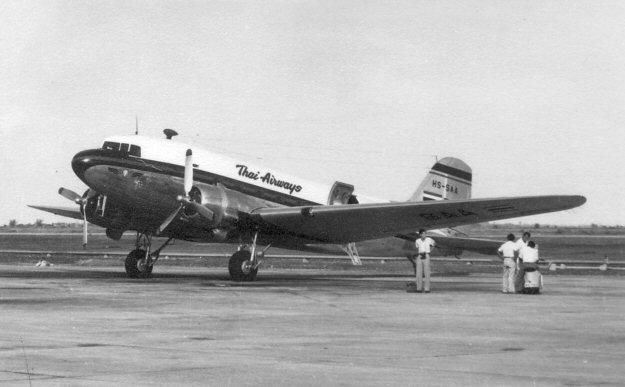
SAC soon discovered it didn’t have the expertise to maintain its Super Constellations and turned to Pan American World Airways (Pan Am) for help. However, by the end of 1958 the Thai Government was dissatisfied with Pan Am’s high costs and tried to negotiate a new contract. The US Civil Aeronautics Board (CAB), which maintained strict control over US airline development, stepped in and blocked any more deals going through. It was then that a representative of Scandinavian Airlines System (SAS) went to Bangkok to assess the situation.
The Scandinavian group was looking to expand its operations, especially into Southeast Asia, and on August 24, 1959 it entered into an agreement with SAC, whereby SAS would takeover and run all the Thai carrier’s main international services, including the prestigious Hong Kong and Tokyo routes. The contract was sealed four months later on December 14, 1959, leading to the creation of Thai Airways International (THAI), with the Thai Airways company (the domestic airline) as its main shareholder (70%) and SAS taking a 30% stake.
On May 1, 1960 THAI took over all Thai Airways Company's international routes, with the exception of its shorter trans-border ones, and launched its first service from Bangkok International Airport to Tokyo via Hong Kong and Taipei. This was followed shortly afterwards by additional flights to Manila and Jakarta via Singapore. By the end of its initial year of operations the airline linked Bangkok with eleven Asian destinations. The carrier’s Royal Orchid Service began to develop a reputation for its in-flight excellence, through its unique Thai-style hospitality and customer care. Quickly its dancing figure logo and the traditional silk air hostess uniforms became recognisable brands. The aim of the joint venture was to create a separate international operation for the domestic carrier Thai Airways Company. SAS also provided operational, managerial, and marketing expertise.
On May 18, 1962 THAI replaced one of its DC-6Bs with a 99-seat Convair CV-990 Coronado leased from SAS; with its four jet engines it was the fastest aircraft of the time.
However, when a second Douglas had to be retired shortly afterwards, the company’s problems began to increase. With a fleet of just two airliners, THAI entered a period of financial uncertainty, forcing it to undertake a severe cost-cutting programme and establish pooling agreements with Cathay Pacific Airways and Malayan Airways on flights from Bangkok to Hong Kong, Calcutta and Singapore. The company’s restructuring averted a major crisis, allowing it time to regroup and consider its future plans. The Hawker Siddeley 748 was delivered to Thai Airways Company in November 1963 for its domestic operations.
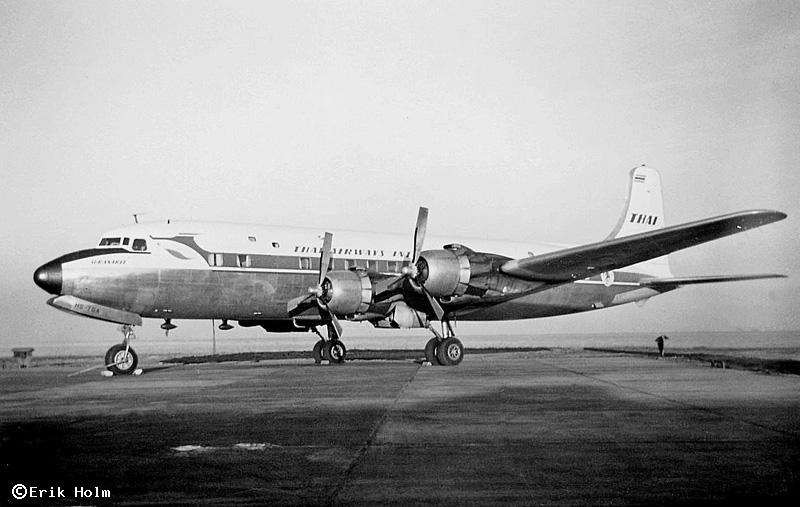
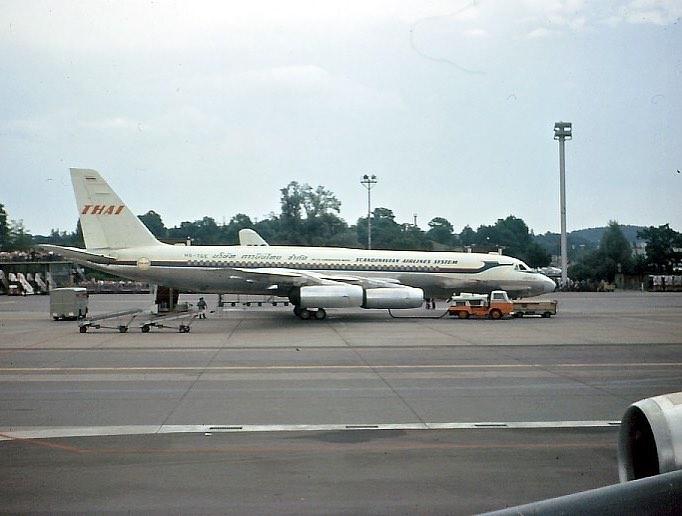
%20748.jpg)
THAI began to evaluate the size of its fleet, and specifically what would it replace the CV-990 with. The obvious choices were the Boeing 707 or DC-8, but both were too large to operate on THAI’s short-medium haul routes. However, it selected the Caravelle with its high standard of comfort, and reduced the normal five-abreast 89 seats to a four-abreast 72 seat layout. The first of five examples entered service on January 1, 1964. When its fifth Caravelle was delivered in 1966, the last DC-4 was retired; allowing THAI to enjoy the distinction of being the first all-jet airline in Asia.
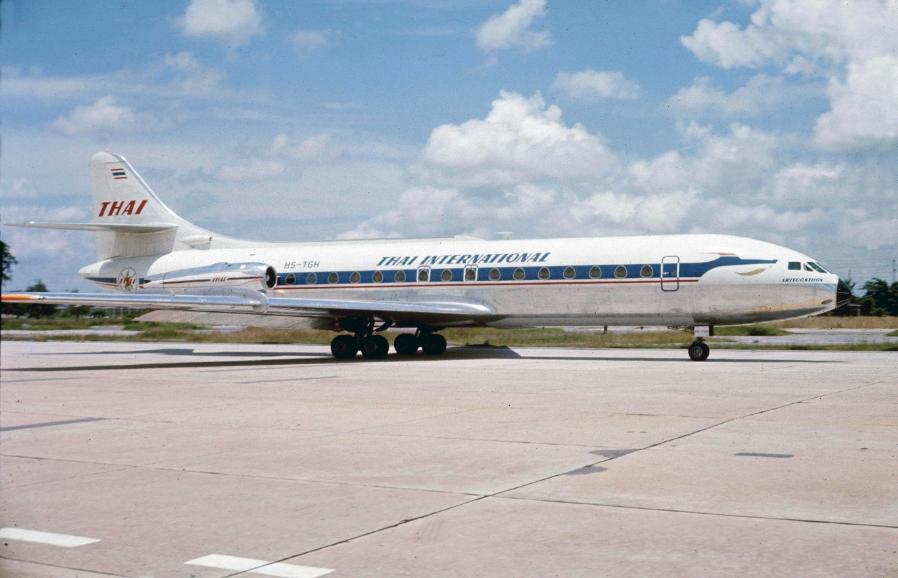
Encouraged by the success of its Bali services, THAI launched flights to the Nepalese capital, Kathmandu. In early February 1969 the airline began upgrading its fleet, initially leasing two DC-9-41s from SAS. Supplementing the DC-9s, it also leased two 146-seat DC-8-32s for use on its long-haul flights. The original ten-year contract with SAS expired in 1970 and both parties were keen to sign an extension to the co-operation agreement, this one lasting for seven years.
On April 1, 1971 it launched a new service to Sydney via Singapore and/or Bali. Two years later, on June 3, 1972 THAI launched its Royal Orchid Service to Europe, flying from Bangkok to Copenhagen with a technical stop in Moscow. The route was made with the stretched DC-8, the -62 series, again leased from SAS. On November 2, 1973 a second Trans-Asian Express route was added, from Bangkok to London via Tashkent. This allowed the airline to fly a through service from London to Sydney, which took just over 20 hours to complete, with two stops in Bangkok and Singapore.
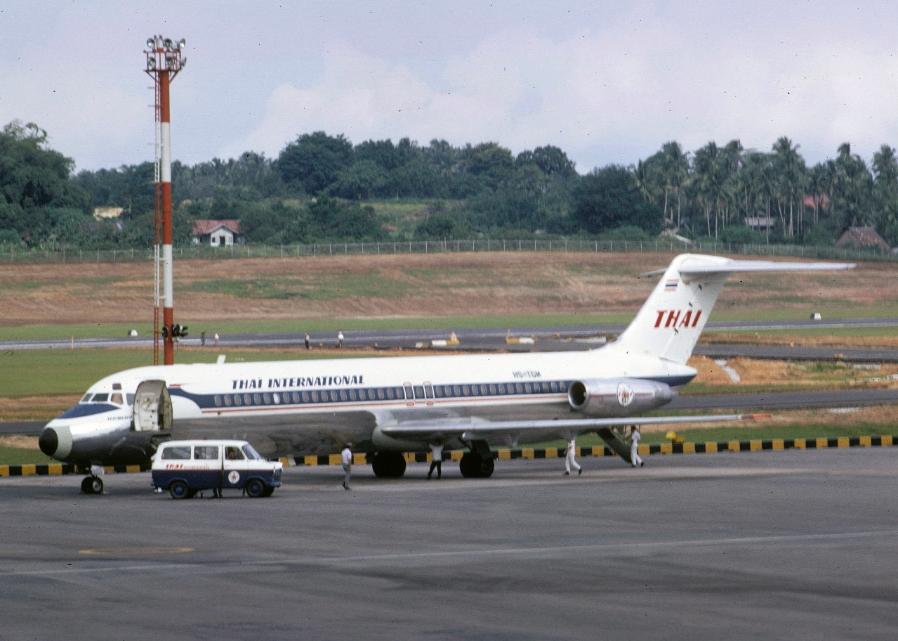
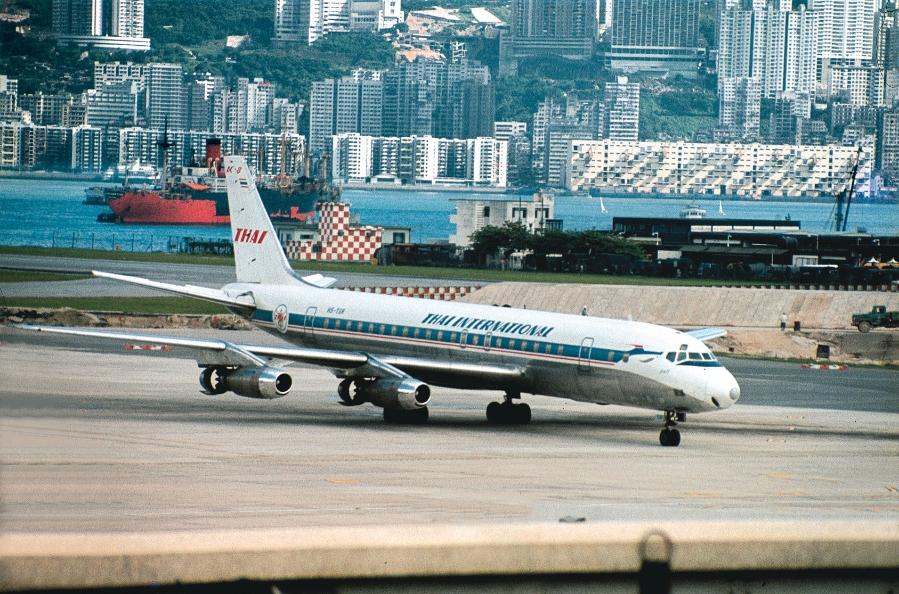
In the mid 1970s, THAI began to reduce its reliance on SAS. It started acquiring additional DC-8s by lease-purchase agreements through the First National City Bank. The Thai Government extended SAS’s contract again on July 16, 1974 but agreed to halve its shareholding from 30% to 15%. THAI flew is first DC-10 service to Amsterdam in March 1975, resplendent in a new stylish livery developed by Walter Landor Associates. The old Thai dancing figure was replaced by a distinctive purple, pink and gold symbol.
On 1 April 1977, after 17 years of capital participation by SAS, the Thai government bought out the remaining 15 per cent of SAS-owned shares and THAI became an airline owned by the Thai government. Also during 1977 the first Boeing 737-200 arrived, the last version of the DC-8, the -61, was operated and services to North America commenced in 1980.
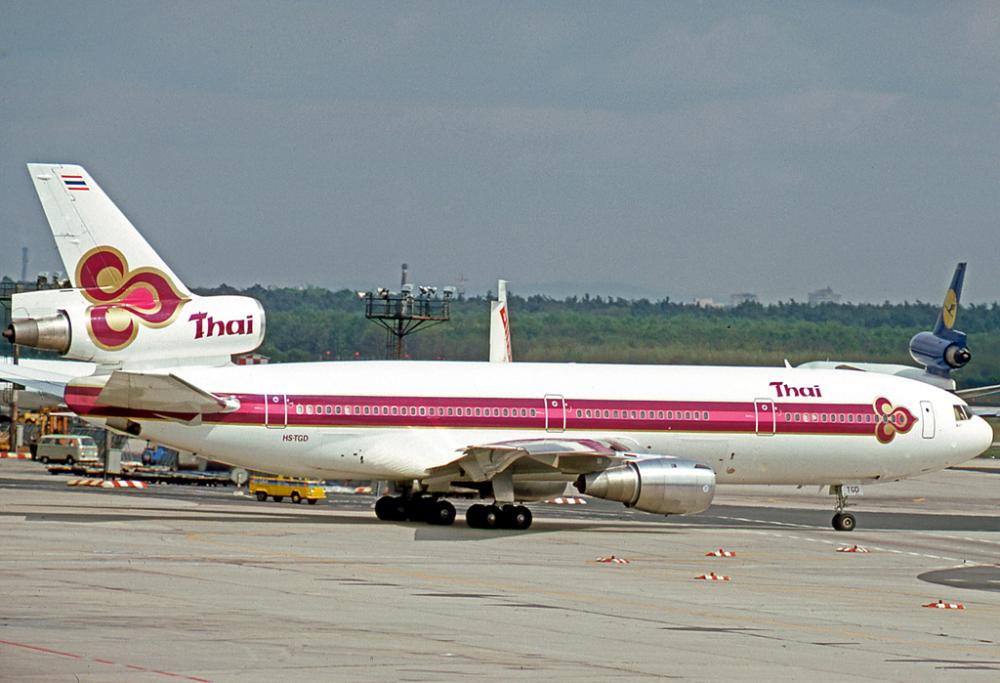
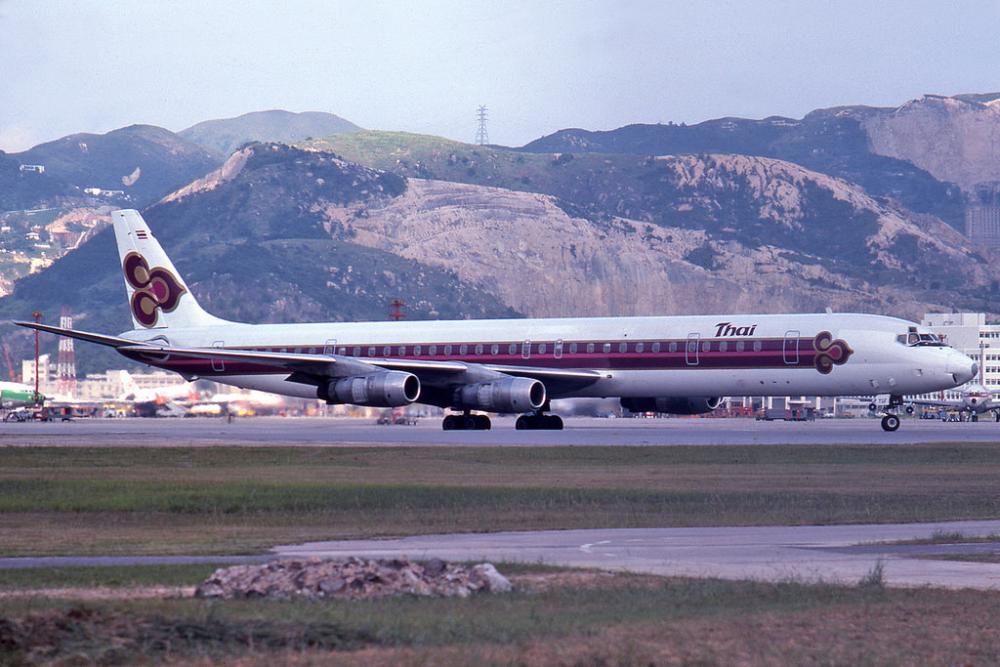
With a surge in air travel around the world and to Thailand in particular, the company took the decision to upgrade its fleet with more wide-bodied airliners. The carrier’s first-owned DC-10-30 (the previous example had been leased) arrived in 1978 and was joined by the Airbus A300B4 later that year. On November 2, 1979, its initial B747 arrived and immediately launched non-stop services from Bangkok to Europe. It had to wait until March 30, 1980, before it finally launched its own trans-Pacific flights, between Bangkok and Los Angeles, with intermediate stops in Tokyo and Seattle. The company’s Royal Executive Class was initially introduced on its regional flights, offering passengers upgraded standards in comfort and convenience. The HS 748s were eventually replaced by Shorts 330s and Shorts 360s. from 1982. A new Maintenance Centre was opened at Bangkok International Airport in 1985 to cope with the maintenance of the ever increasing of aircraft types. Also in 1985 the first Airbus A310 arrived.
The relationship between Thai Airways and THAI was a good one, but towards the end of the 1980s the time was right to rationalise the peculiar situation that both carriers found themselves in, with the small domestic company being a shareholder of the national airline. In the best interests of both organisations they agreed to merge on the 1 April 1988. The new combined carrier operated 41 airliners across a network of 48 destinations in 35 countries, as well as domestic services to another 23 cities across Thailand at that time.
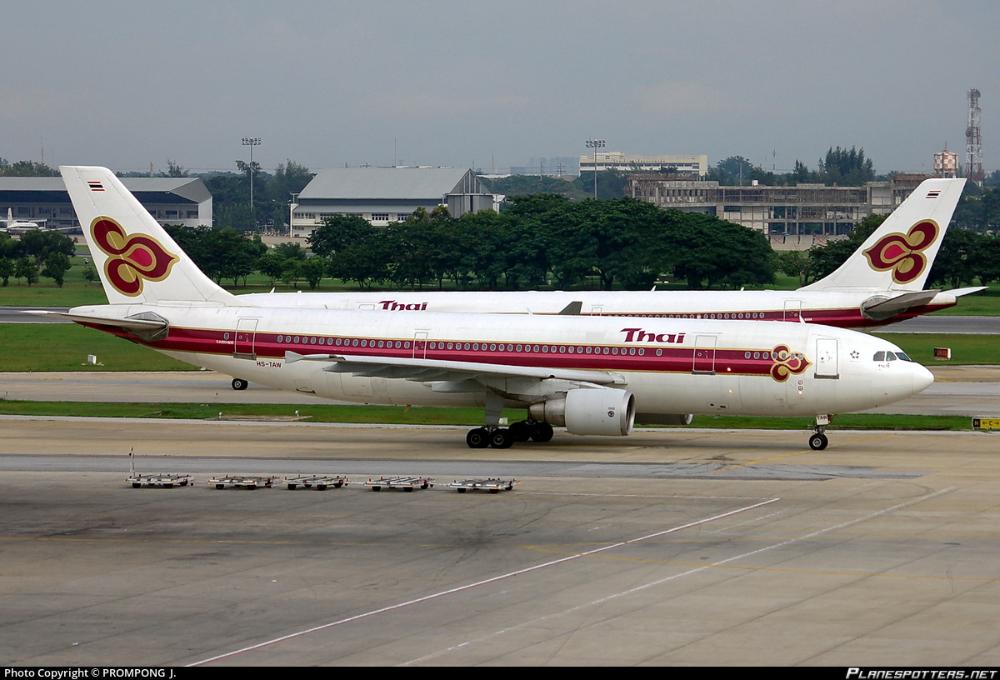
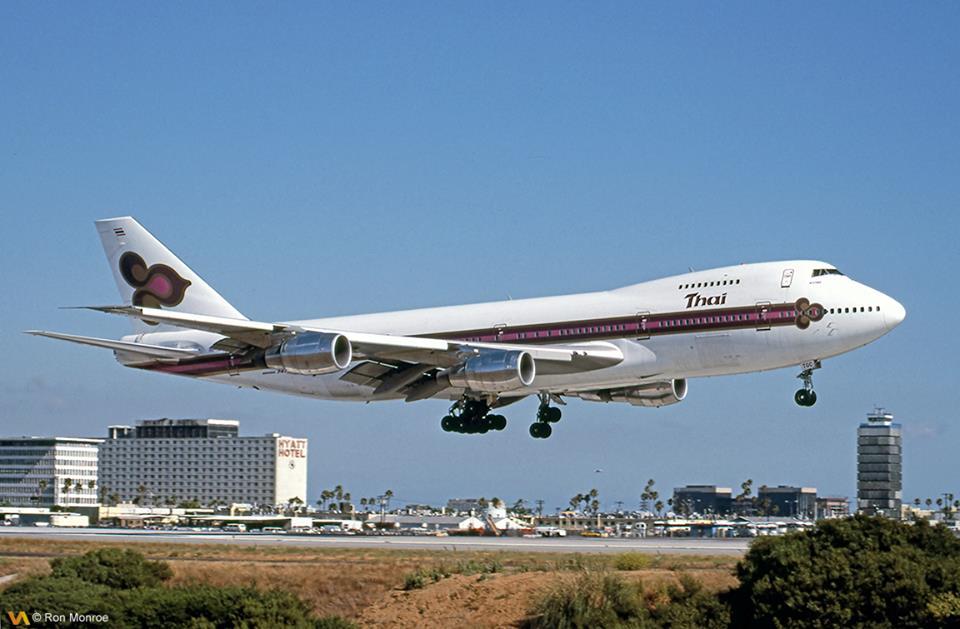
As the unified national airline entered the 1990s, it faced tremendous passenger growth. It required larger aircraft on all fronts, so it leased a fleet of eleven British Aerospace BAe 146s for its domestic operations, while bigger Airbuses A300-600Rs, were acquired for its regional routes around Asia. Additional B747s, including the -400 series, were purchased to enable it to keep pace with its competitors. Its older DC-10s were replaced during 1991/92 by McDonnell Douglas MD-11s.
In 1992 the THAI Government announced its intention to privatise THAI, beginning with 100 million company shares being listed on the Bangkok Stock Exchange. Two years later, on May 20, 1994 THAI was officially registered as THAI Airways International Public Company Limited. The airline continued to invest in new state-of-the-art aircraft, its first Rolls-Royce Trent 800 powered B777-200 was delivered during 1996.
On 14 May 1997, THAI, along with Lufthansa, Air Canada, SAS, and United Airlines, founded the world's first and largest airline alliance, Star Alliance. It also received its first of eleven A330s that joined in the late 1990s.
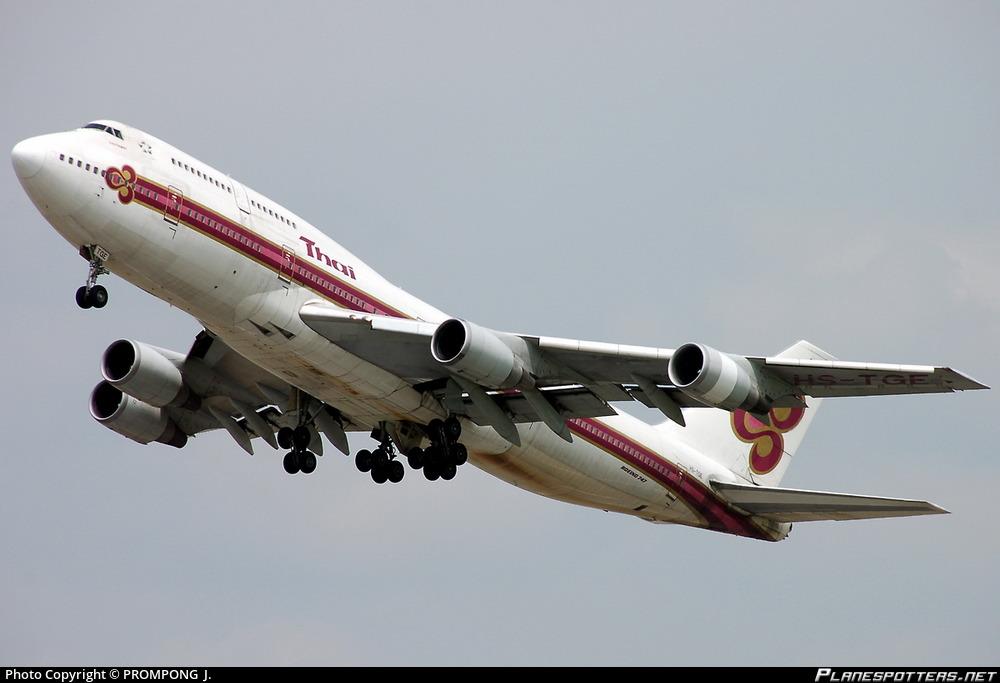
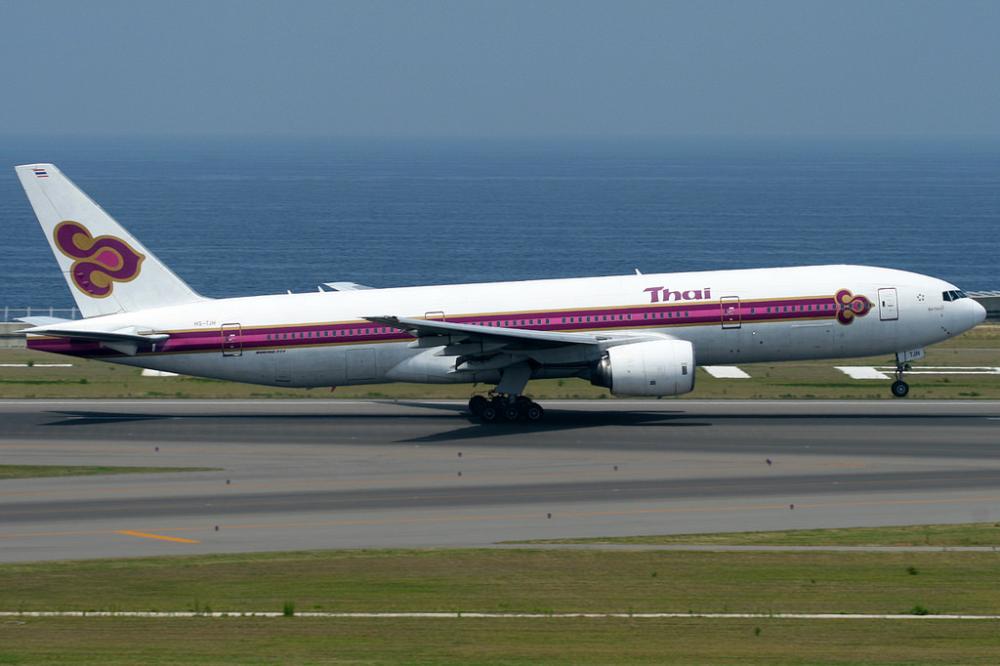
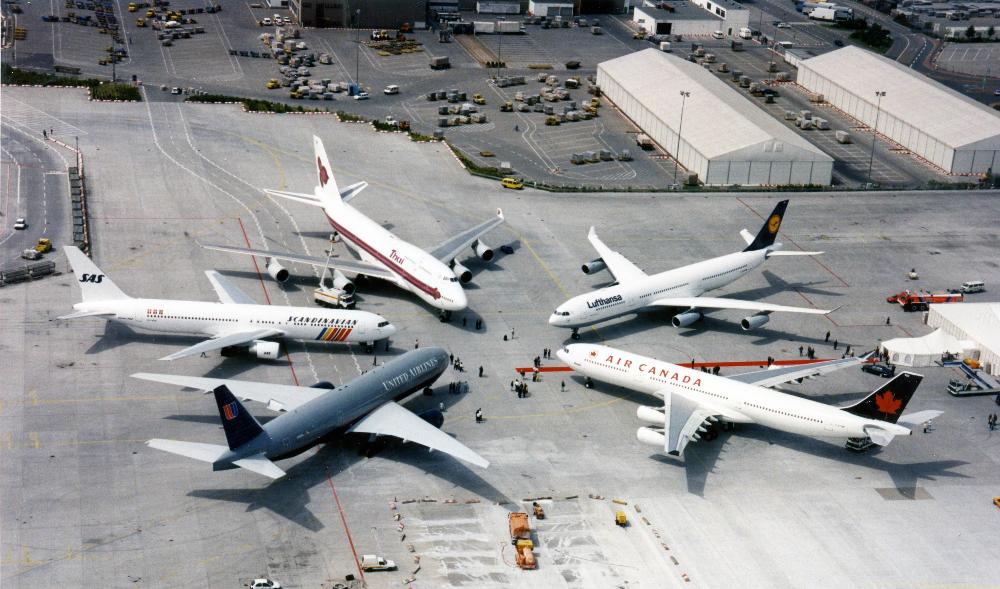
Throughout the 2000s, THAI aggressively continued its route network expansion with new services to Chengdu, Busan, Chennai, Xiamen, Milan, Moscow, Islamabad, Hyderabad, Johannesburg (later suspended) and Oslo. THAI took another major step in its long-term fleet expansion plans in August 2004 when it announced it was placing firm orders for six A380. Also, after almost a quarter of a century since its existing branding had been introduced, THAI decided to unveil a spectacular new corporate image on April 7, 2005. As well as the obvious changes to its aircraft livery, the rebranding influenced a wide range of products from cabin interiors to ticket offices. The first of the company’s fleet to wear the revised livery was a B747-400. As part of the launch celebrations, THAI took delivery of its initial A340-500 (HS-TLA), also with the new livery.
The delivery marked the start of a major Airbus wide-bodied fleet expansion under which six A340-600s and three more -500s were delivered by 2008. The arrival of A340-500, with it extraordinary long range, enabled THAI to launch non-stop Bangkok to New York services, a 17 hour, (14,020km) journey. Using the Airbus A340-500s it acquired in 2005. The airline later converted existing one-stop services to Los Angeles into non-stop services using the same aircraft type.
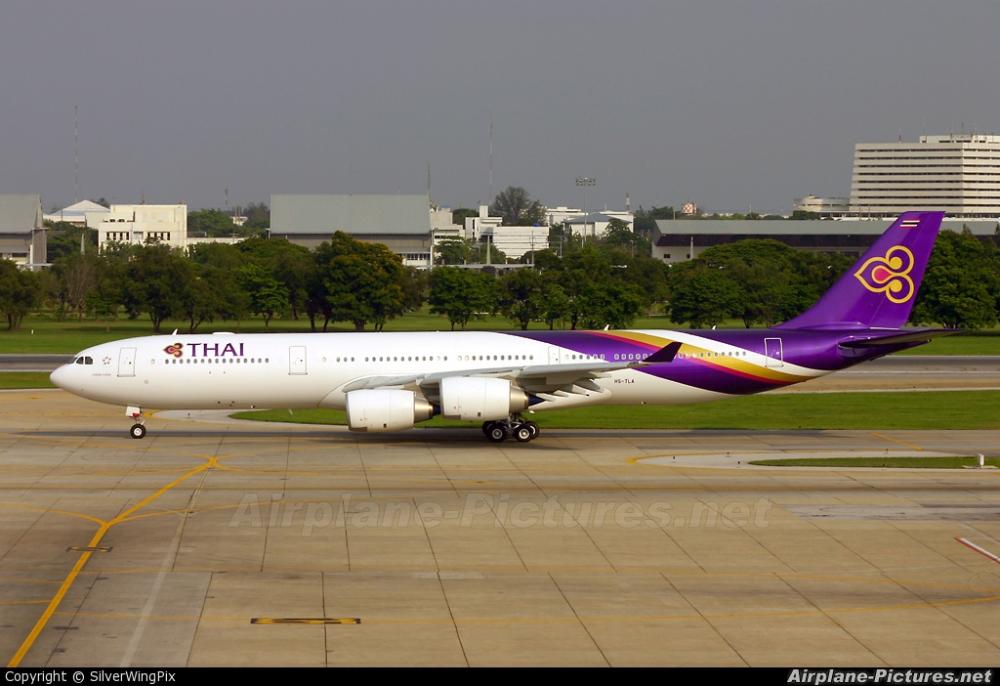
Citing very high fuel costs, THAI discontinued the New York service in July 2008, even though the airline had been able to fill 80 per cent of the seats. The service to Los Angeles was again reverted to one-stop service via Seoul on 1 May 2012, leaving the airline without a non-stop service between Thailand and North America. The A340s were then replaced by used Boeing 777-200ER for the Bangkok–Seoul– Los-Angeles route, and later on Boeing 777-300ER.
In 2006, THAI moved its hub operations to the new Bangkok Suvarnabhumi Airport. Also after 2006, Thai made Phuket airport into its secondary hub by launching direct destinations such as Hong Kong or Tokyo. However, THAI's aggressive growth was hampered by a combination of internal and external factors, including a spike in fuel prices, domestic political conflict in Thailand, and the global economic crisis of the late-2000s. In 2008, after achieving profitability for the previous 40 years, THAI recorded a loss for the first time in its history. As of 2009, after a series of restructuring initiatives, including a two-year deferral of its Airbus A380 deliveries, the carrier returned to a net profit. It received its first A380s and commenced service to Hong Kong on 6 October 2012.
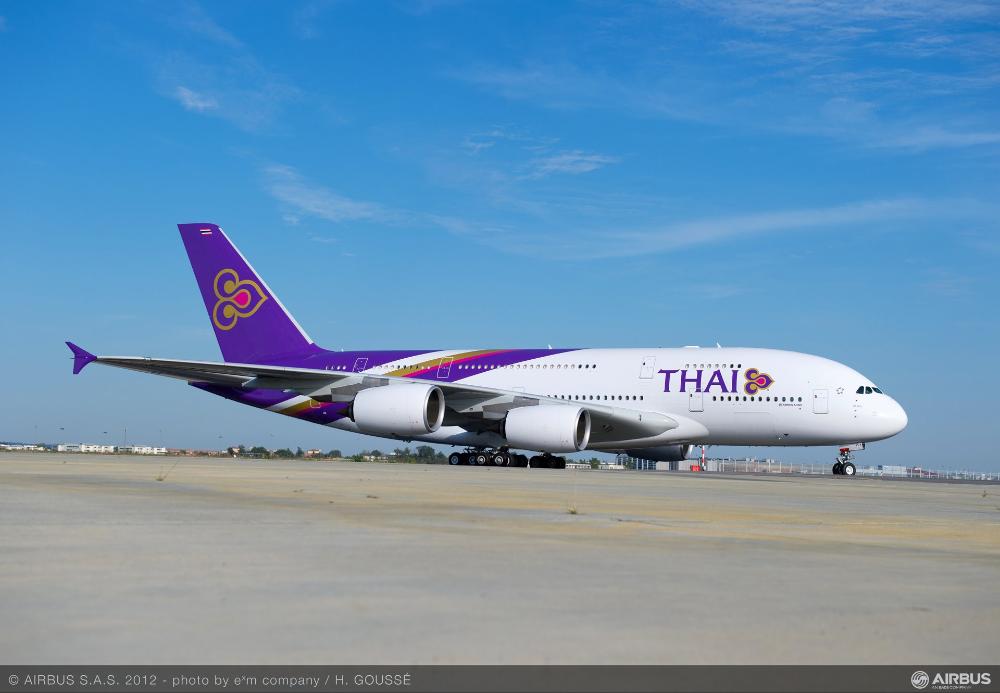
While celebrating its 50-year anniversary in 2010, THAI, began plans for the airline's future, including aircraft fleet renewal and an upgrade of existing services. THAI placed orders for a number of aircraft, including the Boeing 787 and Airbus A350, and also launched a refurbishment of its Boeing 747 and 777 cabins. THAI also resumed its network expansion with the resumption of flights to Brussels, in addition to a new non-stop flight from Stockholm and Copenhagen to Phuket. At the same time, the Greek debt crisis caused THAI to suspend its services to Athens.
As part of THAI's broader growth strategy in the region, THAI launched a regional carrier with light-premium services in July 2011, Thai Smile, which operated the narrow-bodied Airbus A320-200 on regional and domestic routes. (Read more about Thai Smile).
During July 2014, the first 787-8 aircraft operated its first commercial flight from Bangkok to Chiang Mai. With the delivery of the second 787-8 aircraft, THAI operated to and from Perth, Australia and Bangkok to Haneda, Japan.
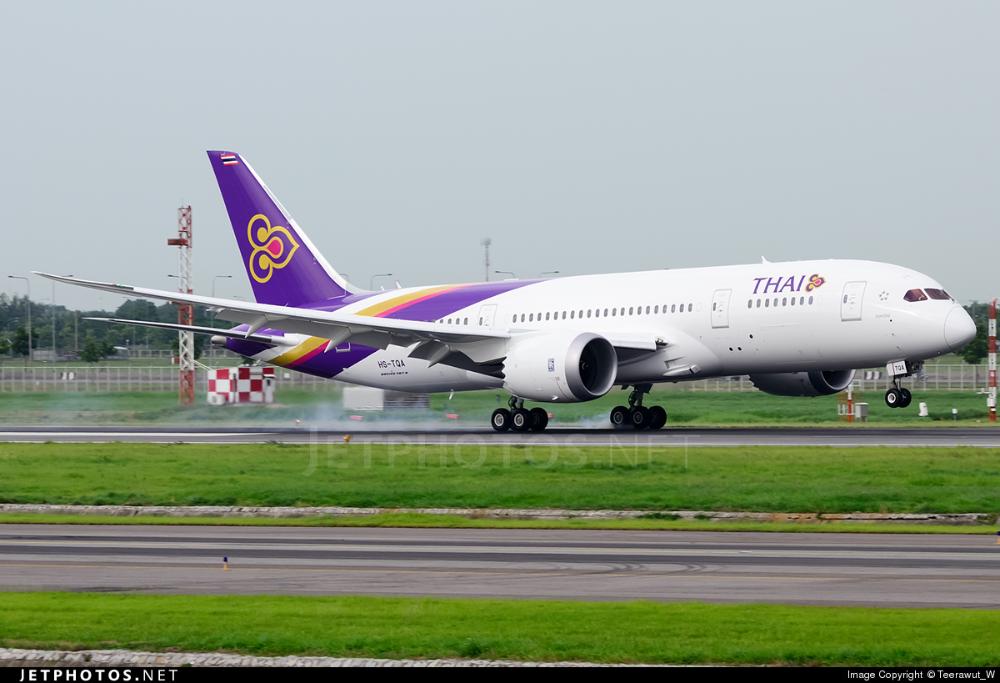
On 1 December 2015, the US Federal Aviation Administration (FAA) announced their reassessment of the safety rating for Thailand, downgrading it from a Category 1 to Category 2 country, the rating means that the country either lacks laws or regulations necessary to oversee air carriers in accordance with minimum international standards, or its civil aviation authority, a body equivalent to the FAA for aviation safety matters, is deficient in one or more areas, such as technical expertise, trained personnel, record-keeping, or inspection procedures. With a Category 2 rating, Thailand's air carriers could continue existing routes to the United States but they won't be allowed to establish new routes to the United States. The European Aviation Safety Agency (EASA) declined to blacklist any Thai carriers following a review of certain carriers in November 2015. THAI later received third country operator (TCO) certification from the EU, effective 15 December 2015, authorizing the carrier to continue flying to the EU for the foreseeable future.
In order to improve its rating and services, the airline was forced to implement some changes. As a consequence, in July 2015, THAI announced the planned cancellation of services to Los Angeles after October 2015, marking the end of US service. It also received 14 new Boeing 777-300ERs, delivered between 2014 and 2015. In June 2016, as a result of its reconstruction plan, THAI announced to commence thrice-weekly Tehran service (however, later it stopped its service on 28 February 2018) and resumed Moscow services from October 2016. New Airbus A350-900 arrived from August 2016, and operated flights to Europe.
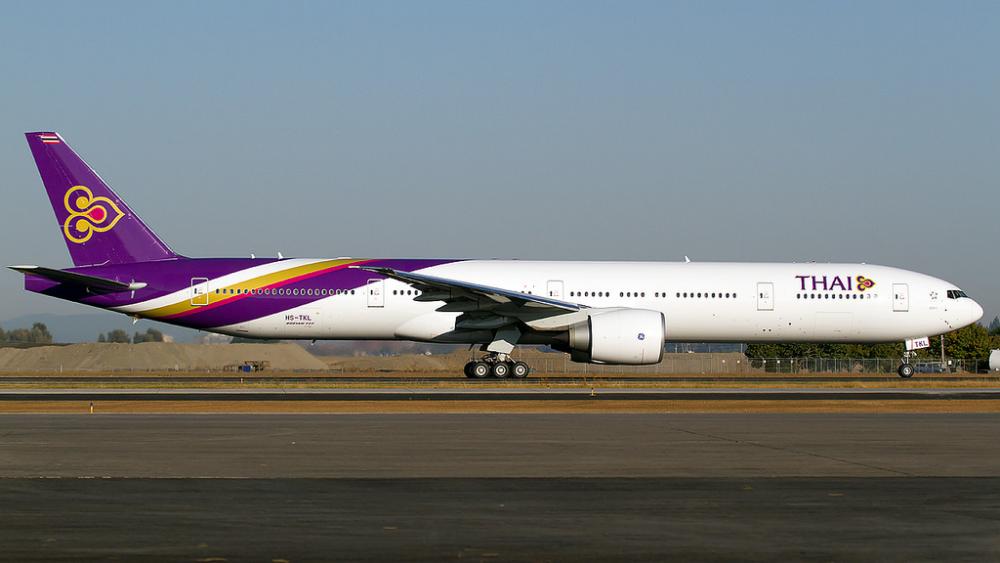
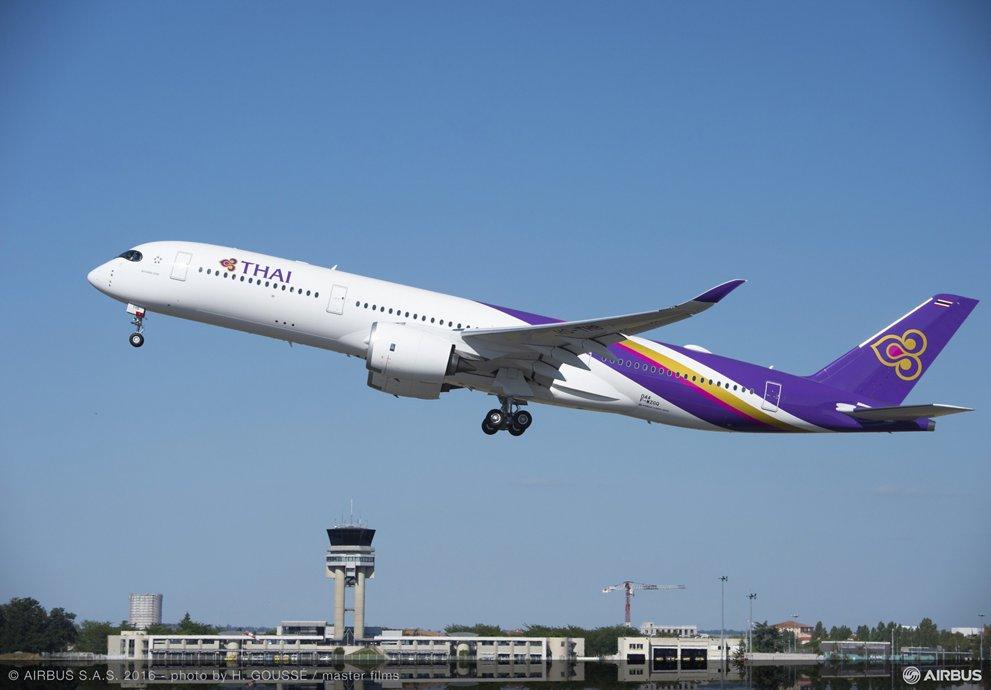
The airline also considered a return to the US using Boeing 787-9 by 2017. However, the THAI president, turned down the possibility of returning to Los Angeles or New York City due to losses in the past. Instead, THAI eyed other cities such as San Francisco and Seattle. In August 2016, THAI introduced new route network management system. In which many of its regional flights would be flown by its subsidiary, Thai Smile. As well it would allow for more connectivity at its major hub at Bangkok by linking transit flights with it’s major international network.
On 20 January 2016 Thai Airways International PCL announced plans to postpone taking delivery of 14 planes for three years to reduce operating costs as the national airline restructured. In 2017, THAI took delivery of seven new aircraft, more Airbus A350-900 and Boeing 787-9, it also decommissioned two leased Airbus A330-300s bringing its active fleet to 100 aircraft by December 2017. From its current plans, 2018 to 2022, it will phase out some Boeing 747-400s and some Boeing 777s and acquire 15 next-generation wide-bodied aircraft to replace them. The 2 Boeing 747-400s (HS-TGF and HS-TGG) will remain in service by public demand and being one of the most iconic aircraft which have become very popular, both with the airline as for its passengers.
THAI consistently ranks among the top three airlines in Asia and top five in the world due to it's high quality product, excellent hospitality and service. It's always providing a smile on all its services because of the land of Thailand, they say, is the land of smiles.
History source: Wikipedia.org + Key.aero + Thaiairways.com
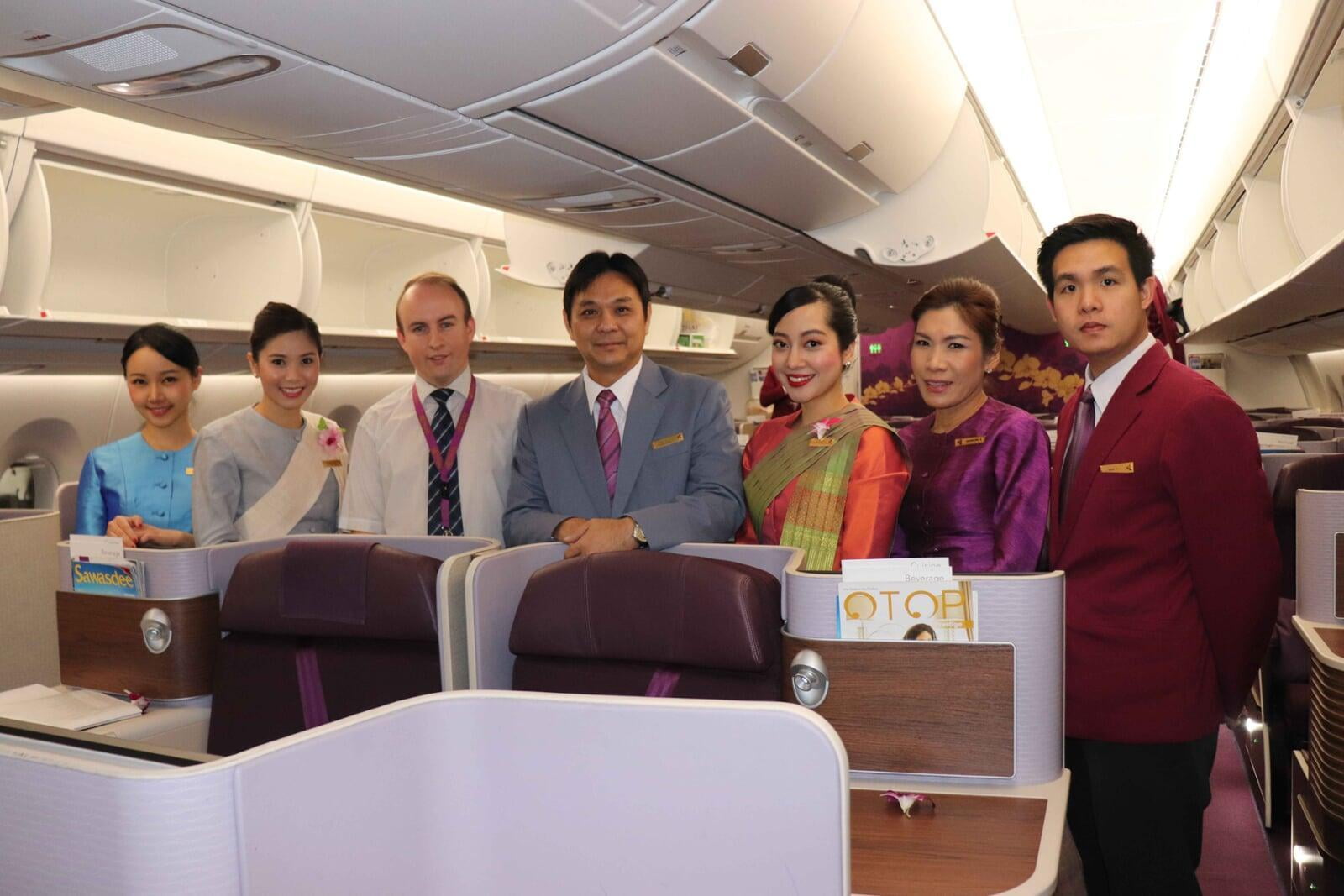
Operations and Destinations 🌍:
The Thai national airline, centralises its operations from its hub at Suvarnabhumi Airport in Bangkok (BKK) and secondary hub at Phuket. It also operates from Don Muang (DMK) in the north of Bangkok, being served exclusively by its subsidiary Thai Smile. THAI (including its subsidiaries) flies to 84 destinations in 37 countries.
Thai Airways International flies to the following destinations, (excluding those served by its regional subsidiary Thai Smile):
| Region 🗺️ | Destinations 🌍🌎🌏 |
|---|---|
| ✈Thailand (domestic) | Bangkok (BKK), Chiang Mai, Chiang Rai, Hat Yai, Khon Kaen, Krabi, Narathiwat, Phuket, Surat Thani, Ubon Ratchathani, Udon Thani |
| ✈Asia | Beijing, Bengaluru, Busan, Cebu, Changsha, Chengdu, Chennai, Chongqing, Colombo, Denpasar, Dhaka, Fukuoka, Gaya, Guangzhou, Hanoi, Ho Chi Minh City, Hong Kong, Hyderabad, Islamabad, Jaipur, Jakarta, Kaohsiung, Karachi, Kathmandu, Kolkata, Kota Kinabalu, Kuala Lumpur, Kunming, Lahore, Luang Prabang, Lucknow, Manila, Mumbai, Nagoya, New Delhi, Osaka, Penang, Phnom Penh, Sapporo, Sendai, Seoul, Shanghai, Siem Reap, Singapore, Taipei, Tokyo, Tokyo, Varanasi, Vientiane, Xiamen, Yangon, Zhengzhou |
| ✈Europe and Russia | Brussels, Copenhagen, Frankfurt, London, Milan, Munich, Oslo, Paris, Rome, Stockholm, Vienna, Zürich. Moscow |
| ✈Australia and New Zealand | Auckland, Brisbane, Melbourne, Perth, Sydney |
| ✈The Middle East | Dubai, Muscat |
*Destination list is for reference only. Please check directly with the airline for updates.
*Note some destinations are only seasonal.*Correct info as of
Fleet ✈️:
Thai Airways has renovated and practically turned around its entire fleet in the last decade. The fleet has enjoyed a much needed rejuvenation with the acquisition of new aircraft, both for its domestic, medium and long haul routes. It now has a very competitive fleet, which matches in fleet age, other major carriers in the region. Thai Airways International uses a mix of Airbus and Boeing products on all its flights, however all aircraft used are wide bodied, even on its short 1 hour popular domestic routes in Thailand. Other services are operated with Airbus A320, operated by its regional partner Thai Smile.
Thai Airways uses the following aircraft in its fleet* (excluding its regional subsidiary Thai Smile):
| Network 🌐 | Aircraft ✈️ |
|---|---|
| ✈Short and Medium Haul (Domestic and International) | Airbus A330. Boeing 777-200, 777-300, 747-400 |
| ✈Long Haul | Airbus A350-900, A380-800. Boeing 777-200ER, 777-300ER, 787-8/9 |
*Correct fleet info as of
Thai Airways Photo Slide 📷:








Thai Airways Safety Video (B787-9) 🎬:
Reviews ⭐:
 |  |
|---|---|
| ✅Member of the Star Alliance for mileage redemption. | 👎No printing boarding pass facility on-line on selected long haul routes |
| ✅ Excellent on-board service, hospitality and welcoming crew. (always with a smile) | 👎 Higher fares. (more expensive tickets) |
| ✅Comfortable seats, good leg-room and nice colourful seating layout. | 👎 No more routes to the USA.(since 2015) |
| ✅ Best airline to fly to Thailand and convenient connections. | |
| ✅ Introduction of new planes (Airbus A380, A350, Boeing B787 and B777) | |
| ✅ Free seat selection at the time of booking directly with Thai. | |
| ✅Emergency seats are not charged for (must request at airport) | |
| ✅ Included in the ticket price: luggage and meals | |
| ✅Free online check-in and seat selection |


.png)